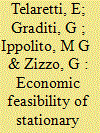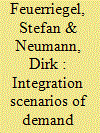|
|
|
Sort Order |
|
|
|
Items / Page
|
|
|
|
|
|
|
| Srl | Item |
| 1 |
ID:
175893


|
|
|
|
|
| Summary/Abstract |
In this paper, we examine the electrification of the heating sector as a decarbonisation strategy, discuss its effectiveness, and preliminary assess its impact on the European power system. For this purpose, we perform a complete description of the EU heating sector compliant with official statistics and decompose the EU power demand in different uses to define and assess different levels of heat electrification. We find that heat electrification is an effective decarbonisation option, which can reduce the total energy related emissions by up to 17%, if paired with simultaneous expansion of low-carbon energy. Due to the relative sizes of heat and power demands, we find that most national power systems could cope with higher heat-electrification rates. Specifically, an additional heat pump capacity in the order of 1.1–1.6 TWth can be deployed based on the existing firm power capacity, which would correspond to a heat pump share of 29–45% in space heating. Based on their current power capacity, 12 Member States are prepared for even full electrification scenarios, whereas three Member States could get their power system stressed if 40–60% of all fossil-fuelled technologies are substituted. Flexible electric demand is identified as a key enabler of larger heat electrification shares.
|
|
|
|
|
|
|
|
|
|
|
|
|
|
|
|
| 2 |
ID:
110755


|
|
|
|
|
| Publication |
2011.
|
| Summary/Abstract |
Within the next years, consumer households will be increasingly equipped with smart metering and intelligent appliances. These technologies are the basis for households to better monitor electricity consumption and to actively control loads in private homes. Demand side management (DSM) can be adopted to private households. We present a simulation model that generates household load profiles under flat tariffs and simulates changes in these profiles when households are equipped with smart appliances and face time-based electricity prices.
We investigate the impact of smart appliances and variable prices on electricity bills of a household. We show that for households the savings from equipping them with smart appliances are moderate compared to the required investment. This finding is quite robust with respect to variation of tariff price spreads and to different types of appliance utilization patterns.
Finally, our results indicate that electric utilities may face new demand peaks when day-ahead hourly prices are applied. However, a considerable amount of residential load is available for shifting, which is interesting for the utilities to balance demand and supply.
|
|
|
|
|
|
|
|
|
|
|
|
|
|
|
|
| 3 |
ID:
150633


|
|
|
|
|
| Summary/Abstract |
Battery energy storage systems (BESSs) are expected to become a fundamental element of the electricity infrastructure, thanks to their ability to decouple generation and demand over time. BESSs can also be used to store electricity during low-price hours, when the demand is low, and to meet the demand during peak hours, thus leading to savings for the consumer. This work focuses on the economic viability of BESS from the point of view of the electricity customer. The analysis refers to a lithium-ion (Li-ion), an advanced lead-acid, a zinc-based, a sodium-sulphur (NaS) and a flow battery. The total investment and replacement costs are estimated in order to calculate the cumulated cash flow, the net present value (NPV) and the internal rate of return (IRR) of the investment. A parametric analysis is further carried out under two different assumptions: a) varying the difference between high and low electricity prices, b) varying the peak demand charges. The analysis reveals that some electrochemical technologies are more suitable than others for electric bill management applications, and that a profit for the customer can be reached only with a significant difference between high and low electricity prices or when high peak demand charges are applied.
|
|
|
|
|
|
|
|
|
|
|
|
|
|
|
|
| 4 |
ID:
124376


|
|
|
|
|
| Publication |
2013.
|
| Summary/Abstract |
The aim of this paper is to show the economic potential of demand response (DR) on household level at Central European market conditions. Thereby, required economic benefits for consumers' participation, the realistic load shifting potential at household level and the estimation of essential intelligent infrastructure costs are discussed. The core of this paper builds a case-study applying spot market-oriented load shifting from the supplier's point of view by using Austrian electricity market data, household load profiles as well as a heat pump and e-car charging load profile. It is demonstrated which cost savings for suppliers can be derived from such load shifting procedure at household level. Furthermore, upper cost limits for intelligent infrastructure in order to break-even are derived. Results suggest to take a critical look at European discussions on DR implementation on household level, showing that at Central European market conditions the potential for DR at household level is restricted to significant loads and hence, the applied load shifting strategy is only beneficial with application to heat pumps. In contrast, the frequently discussed shifting of conventional household devices' loads (such as washing machines) economically does not add up.
|
|
|
|
|
|
|
|
|
|
|
|
|
|
|
|
| 5 |
ID:
149969


|
|
|
|
|
| Summary/Abstract |
Demand Response allows for the management of demand side resources in real-time; i.e. shifting electricity demand according to fluctuating supply. When integrated into electricity markets, Demand Response can be used for load shifting and as a replacement for both control reserve and balancing energy. These three usage scenarios are compared based on historic German data from 2011 to determine that load shifting provides the highest benefit: its annual financial savings accumulate to €3.110 M for both households and the service sector. This equals to relative savings of 2.83% compared to a scenario without load shifting. To improve Demand Response integration, the proposed model suggests policy implications: reducing bid sizes, delivery periods and the time-lag between market transactions and delivery dates in electricity markets.
|
|
|
|
|
|
|
|
|
|
|
|
|
|
|
|
| 6 |
ID:
168647


|
|
|
|
|
| Summary/Abstract |
To date, research on demand side management has mostly focused on the determinants of electricity consumption and stated preference experiments to understand social acceptability. Further experimental research is needed to identify the determinants for demand response schemes. This paper contributes to addressing this gap by making use of data from a randomised control trial which contains 15 months of smart meter electricity data combined with household characteristics and differences in incentives to shift their electricity use between 11am and 3pm. Cluster analysis performed on electricity data identified three distinct electricity daily load profiles. Each cluster was then linked to household characteristics by means of a multinomial logistic regression to identify the determinants of the load curves' shapes. Findings show that occupancy presence at home, age and appliance ownership were strong predictors. Finally, this paper is among the first to provide experimental evidence on the determinants of load shifting. We find that households with head aged above 65, households who belong to the cluster exhibiting a load profile characterised by a relatively high peak at noon and a low peak in the evening, and those who received money incentives were more likely to shift electricity use towards middle of the day (11am-3pm).
|
|
|
|
|
|
|
|
|
|
|
|
|
|
|
|
|
|
|
|
|